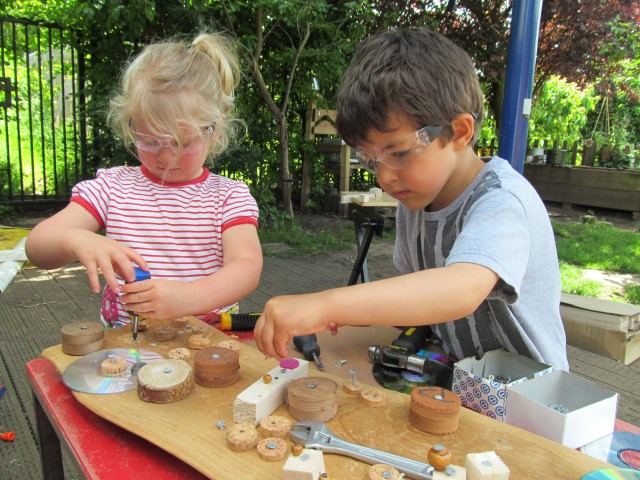This post features a review of Peter Moorhouse’s book ‘Learning Through Woodwork‘ – a wonderful publication for practitioners that outlines the importance of woodwork in the early years.

Back when I was attending kindergarten, in early 1990’s regional Australia, the only cross-cuts saws and drills in use were imaginary ones that I would get out to cut off the boys’ arms.
A lot has changed since those days and woodwork – as a creative activity for children to learn – has witnessed an exciting resurgence in preschools around the world.
Peter Moorhouse’s recent book‘Learning Through Woodwork: Introducing Creative Woodwork in the Early Years’is a fantastic practical guide for teachers and practitioners working in early years’ settings.
Peter is a real-life, professional sculptor who also has 25 years’ experience working as an art educator in schools and kindergartens. In this book, he shares his expert knowledge and tips for how woodwork can be implemented with young children in preschools.

Why is woodwork important?
Woodwork is a unique activity for children to learnthrough. For example, children are able to work with natural materials and use real tools to solve unexpected problems. They can also express themselves and follow their curiosities while tinkering with wood.
In the book, Peter talks about the special ability of woodwork to build a child’s self-esteem and confidence.

The history of woodwork in early years education
Unsurprisingly, woodwork has been an important part of young children’s learning for hundreds of years. For example, in Froebel’s first kindergarten he introduced wooden objects to children to stimulate learning and curiosity. He also believed that:
“To learn in life through doing is about developing, cultivating and strengthening. This is much more than to learn merely through verbal communication.” Froebel, 1826 (1)
Similarly, Waldorf and the Sloyd education movement in Scandanavia also advocated strongly for children’s play and tinkering with wood.
Woodwork was then basically eliminated from early years settings in the United Kingdom in the 1980’s and 1990’s. This happened as a result of strict health and safety measures and a simultaneous shift in educational priorities.
More recently, there has been a renewed interested in woodwork around the world. This has happened alongside the rise in Forest Schools, the tinkering movement and maker spaces in schools.

How can woodwork be introduced to very young children?
Before reading this book, one of the biggest questions I had was, ‘how can little kids use hammers, drills and saws safely?’
The book discusses this topic in detail by featuring in a comprehensive ‘how-to-do’ section. This includes information on how to set up activities over time that allow children to develop their knowledge and skills. For example, Peter recommends introducing woodwork to first-year pre-schoolers by allowing them to play with wooden blocks and objects.
In addition to this, investigating natural areas, such as woodlands, can also encourage children to learn about where wood comes from and its different forms such as bark, driftwood, twigs, branches, sawdust and tree rings.
It is useful to note that the author does not recommend children under the age of 3 use real tools. This is due to the risk of injury being too high. Alternatively, these tools may be gradually introduced as children enter and progress through preschool.
The book also details how children can safely work with authentic woodwork equipment. For example, how basic woodwork tools – such as hammers, clamps and sandpaper – can be sequentially introduced to children. By following these steps, woodwork becomes a low-risk activity when introduced and monitored correctly. It also features a chapter on understanding risk, doing risk assessments and staff training.

What sort of woodwork activities can be done in kindergartens?
My favourite part of ‘Learning Through Woodwork’is the section on woodwork projects that can be done in early years settings. I especially love how the book talks about ongoing woodwork ‘projects’ instead of doing one-off activities. These projects can last over several weeks and allow children to extend their learning through in-depth experimentation with tools, techniques and materials over time:
“Extended projects can last over several sessions, weeks or even months and are collaborative, with a group of children working together. They provide a wonderful opportunity for children to learn from each other. They gain experience of how other think, thus expanding their creative and critical thinking skills. They build on each other’s ideas as they refine designs and work out potential solutions to problems together (taken from page 142 of the book).”
Practical suggestions for projects are then given including creating a sculpture, sound garden, cubby house, mud kitchen and wooden frieze. The images in this blog posts are of children participating in a sculpture project.
Overall, Learning Through Woodworkis a wonderful and extremely useful guide for anyone working in an early year’s settings that is interested in giving woodwork a go! The book is particularly focused on how woodwork can be integrated into kindergarten curriculum in the United Kingdom, i.e. those settings using the Early Years Learning Framework. However, it would also be a great resource for early childhood educators using different curriculums.
A link to Peter’s website, where you can find everything you need to know about woodwork in the early years is included below.
(1). Froebel, Friedrich (1826). Die Menschenerziehung (on the education of man,Keilhau, Leipzog: Weienbrack.
Related Links
You can order ‘Learning Through Woodwork on the Routledge website here: https://www.routledge.com/Learning-Through-Woodwork-Introducing-Creative-Woodwork-in-the-Early-Years/Moorhouse-Bruce/p/book/9781138071100
Peter’s website ‘Irresistible Learning’features LOTS of resources to help you get started doing woodwork in the early years. For example, there are risk assessment forms, health and safety guidance and practical tips.
The Importance of Woodwork in Early Childhood Education– An article written by Peter Moorhouse on why woodwork is significant in children’s learning.

Related Posts to woodwork in the early years
Thinking with your hands: A visit to the Tinkering Studio in San Francisco
Tips for arranging materials to support children’s learning
Children’s creative learning through the art of Sheila Hicks




